
|
|
24 June, 2000
24 June 2000
How Do You Propel 420’ of Icebreaking Steel?
With some great big honking engines, and a talented crew to keep them
running! How big are these engines? I asked that question of you in June
11th’s journal and today we’ll revisit the questions as these engines power
us toward the southern tip of Greenland. The answer - the four generators
of USCGC Healy’s Integrated Power Plant (IPP) each generate 10,800
horsepower for a total electrical output of 29 megawatts of electrical
power. Some of this power is used for “hotel services” such as lighting,
heating and ventilation. The rest goes to the two motors that drive the
propellers that drive this ship. Each of those motors delivers 15,000
horsepower, for a combined power of 30,000 horsepower to propel this
icebreaker during each mission.
How do you find out if it is actually capable of this power? Find
something the ship can push that won’t move, and crank those engines up.
This is one of the things done on Leg 3. The ship eased into a large
pressure ridge and started pushing. The ship could have broken through the
ridge by backing and ramming (see Sandi Kolb’s journal), but that wasn’t the
goal. The ice held and the engineers discovered the ship was developing too
much torque and heating up one of the transformers. This is something they
will test and fix during their transit of the Northwest Passage.
These engines require a talented group of individuals to keep them running
in peak operating condition. That responsibility falls on the shoulders of
the ship’s engineering crew. LCDR Neil Meister, the Engineer Officer, and
Lieutenant Troy Kunas, the Assistant Engineer Officer, lead these 35 men and
women as they keep on top of a system LT Kunas describes in the following
way - “The power distribution and monitoring system are hands down the most
complicated system I’ve ever worked with”. That is saying a lot
considering Troy has 20 years with the Coast Guard and 10 years of
experience with the Polar Sea and Polar Star, the Guard’s other two
icebreakers. He is what is known as a “mustang” - he worked his way up
through the ranks to achieve officer status. He designed many of the
controls on those two vessels and “that experience led to him being hand
picked for the HEALY”. That selection has been both an honor and a
hardship. While attending the HEALY’s construction and sailing on its test
cruises, LT Kunas will only have been home 30 days in 18 months upon HEALY’s
arrival in Seattle. A challenge when you miss your wife of 20 years, 16
year old son, and 14 year old daughter. Before the HEALY position, the
longest Troy had been on a ship was 7 months. He loves running the
integrated power plant (IPP) of this cutting-edge vessel, but looks forward
to getting back to his family in Seattle as soon as possible.
The engineering department on the ship is divided into areas of
responsibility. They make up nearly half the ship’s crew and have enough
work to keep all the public utilities of a small city quite busy. The E & E
(Electronics and Electricians) officered by LTJG DeNucci are divided into
those responsible for the propulsion system and those responsible for all
the other electronic and electrical systems. The MK’s or Machinists are
also divided into two main groups. Again, those responsible for the
propulsion system (Main Prop) and A-Gang, those responsible for things like
air-conditioning, heating, water. The third group of engineers is grouped
as “Damage Control”. They are responsible for fire protection, machine
work, and fabricating pieces of equipment that may not be available on the
ship. Pictures of each of these groups follow, but I’d also like to
introduce a couple more of them to you “in person”.
MK2 (Machinery Technician 2nd Class) Jeff Pierce grew up in McMinnville,
Oregon, not far from where I teach. Jeff somehow knew long ago he wanted to
be in the Coast Guard. As a first grader, when it came time to write down a
little bit of info about himself, in the space next to what he wanted to be
when he grew up, Jeff wrote “Coast Guard”. Perhaps it was seeing USCG ships
at the Oregon Coast where his family would go and he would watch the boats.
Regardless of what triggered the interest, Jeff went right to the Coast
Guard recruiter the day he turned 18. He spent a year and a half on the
USCGC Polar Sea sailing to places like Australia, Antarctica, and later to
the North Pole. He went from one of the fleet’s largest ships, to Sault
Ste. Marie, Michigan where he served in a ten-man unit that had one 25’ boat
and one 21’ boat. He really enjoyed the history of the place, both its
early role in American Settlements (third oldest) and its pivotal role in
WWII. During that war, it was a key link for iron on its way to Detroit and
was heavily guarded by the army and defended from potential air attack by an
anti-aircraft detachment. Jeff again got a traveling assignment on the
USCGC Healy where he likes being on a good ship with good people, but like
most people I’ve talked too, this extra long assignment makes it a long time
away from home. Jeff’s seven years in the Guard have, and will, take him
all over the world, something he didn’t really imagine would be possible as
part of a job.
ETC Jim Flynn, Chief Electronics Technician, grew up in Juneau, Alaska and
joined the Coast Guard when he was recruited as a freshman in college. He
has diverse experience in the Guard serving on the USCGC Yocona out of
Kodiak, Alaska, working at Air Station San Diego, and also working at a
LORAN Station in George, Washington. Yes, that is the town of George, in
the state of Washington. His wife and two children live in Seattle, and
like many of the crew, Jim has been apart from them for a long time with the
initial construction and testing of USCGC Healy. Due to its extremely
advanced electronics systems, upon which nearly everything on the ship is
based, the ship has presented unique challenges for Jim and all the other
folks in his department. In spite of the headaches generated by a vessel
dramatically more electronically complex than any other Coast Guard ship,
ETC Flynn wouldn’t trade the opportunity to work and travel on the HEALY for
anything.
Each of the members of the engineering crew deserves to have their own
story written, but with limited space, a few cameo appearances will have to
do. All of them are key components in the efficient operation of this
impressive vessel. The departments are shown in the photos below. To each
of them, I owe my thanks for making me feel at home on USCGC Healy.

DC Shop - You Need, They Make It!!!
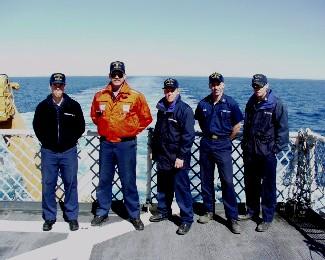
Damage Control: ENS Plyler, ECC Leeper, DC1 Bogue, DC3 Klein, DC1 Green.
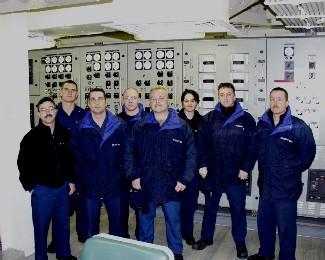
A-Gang: MKCS Campbell, MK3 Lightcap, MKC McClellion, FN Holman, MK1 Emsminger, FN Keeler, MK2 Small, MK2 Krantz.

Two of USCGC Healy’s enormous generators.

Main Prop: MK2 Lowden, MK2 Small, MK2 Williams, MKC Bailey, MK2 Bennett, MK3 Maes, FA Juno, FN Seifreid, MK2 Pierce.
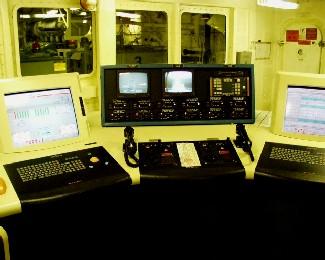
Main Propulsion Control Monitoring System.
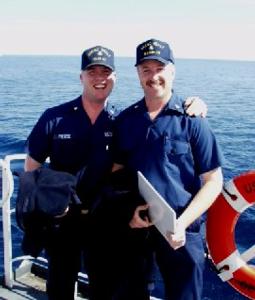
Good Friends Jeff Pierce and Jim Flynn.
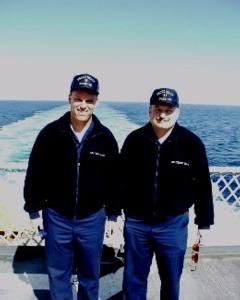
LCDR Neil Meister and LT Troy Kunas.
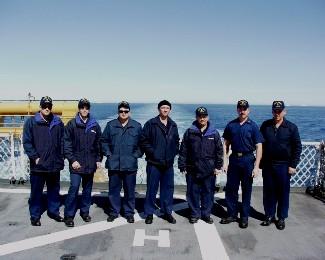
Systems: TT1 Hagood, ET2 Millington, ET2 Woolever, ET2 MicKinley, EMC Pederson, ETC Flynn, ETMC Churchill.
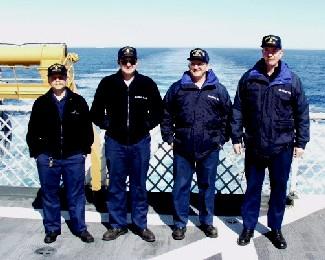
E-Prop: ET1 Pedigo, EM1 Hulen, EMC Inget, EMCM Turner.
Contact the TEA in the field at
.
If you cannot connect through your browser, copy the
TEA's e-mail address in the "To:" line of
your favorite e-mail package.
|
